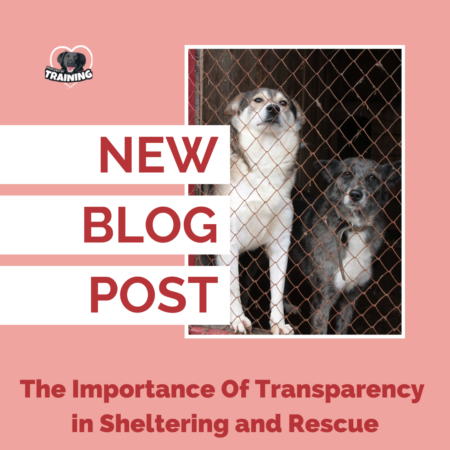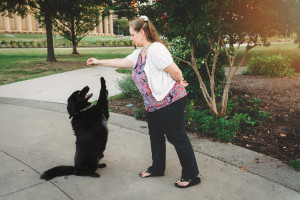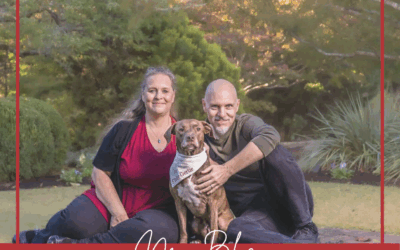Much like the lack of transparency in dog training, there’s also a lack of transparency in sheltering and rescue organizations. In 2018 eight prominent animal welfare organizations and foundations released a joint mission statement regarding accountability and transparency regarding data sharing of the numbers of animals in their care and their outcomes. Shelter Animals Count partners with various sheltering organizations to collect standardized data for their National Database, with a long-term goal of 100% shelter participation nationwide. But this primarily tracks intake/outcome numbers like how to count the animals in care and to attempt to standardize how these organizations calculate the coveted “live release rate” (LRR) so they can say they have “no-kill” status.
But what about transparency with adopters and those looking to donate to organizations? What information is and isn’t conveyed or publicly available? What about transparency in communication regarding training methods and handling techniques? What about accuracy of age, breed, medical history and behavior, including bite history? Many of these may be disqualifiers to adoptability, which in turn would affect the LRR or other important measured criteria like length of stay at the shelter or returns. This could further impact public perception, which would impact donations. It’s a snowball effect, so it makes sense why some rescues and shelters may want to keep a tight lid on certain information.
And from personal experience in both private rescues and sheltering, withholding “non-essential” information from adopters was sadly part of the adoption equation in many organizations. Younger dogs, dogs of certain breeds, dogs without health or behavioral issues, all tend to get adopted out more quickly than older dogs with behavioral or medical issues, so that could be a motivator for groups to err on the side of adoptability, rather than the transparency.
Why is all of this important? Well, besides the obvious ethical/moral issues of intentionally lying or hiding information, it leads to well-intentioned people committing to adopt an animal that they believe is healthy (or a certain age or breed or with a certain behavioral or training history) but later discover fallout from that misleading information, whether it be financial (unexpected training or medical expenses) or emotional (surrendering back or euthanizing a dog the family wasn’t prepared to handle). In my behavior practice I’ve had countless people come to me after getting a dog that was more than they bargained for or had issues that were not properly disclosed.
So how can you protect yourself? ASK, OBSERVE AND RESEARCH. Conflicting answers or reluctance to answer questions are red flags.
- Don’t just go where the cute puppies are. It can be tempting if a rescue or shelter has a constant supply of designer breeds or purebred puppies, but use common sense – where are they sourcing them from? 8-week-old designer puppies don’t just fall into the lap of rescues week after week. Many rescues claim they have “rescued” puppies, when really they’re often coming from backyard breeders, puppy auctions or other unscrupulous sources.
- Request to see all medical records, not just vaccine records. Ask if their staff or partner vet is available for you to discuss any concerns you have. Look for any discrepancies between intake paperwork and what is being advertised. Glaring age, breed or weight differences should be a red flag. Changing, falsifying or intentionally withholding records is a crime.
- What is the dog’s known history – not just where did this organization get the dog but what do they know before then? Was it stray? Owner surrender? Hoarder? Puppy mill dog? Meat market dog? Street dog from another country? History is important because dogs with poor early socialization or bad experiences may require more extensive training.
- What socialization has the rescue or shelter been doing, especially if it’s under 14 weeks of age? Do they have the puppy’s mother? If the mother is available/known, insist on meeting her. There is a strong likelihood that if the mother is fearful, the puppies will be fearful. What interactions has the dog had with children, cats or other dogs?
- Ask to see a behavioral assessment. Inquire about guarding behaviors, body handling and sociability observed while the dog has been in their care. Concerns should be discussed with their certified trainer (who should also be the one administering behavioral assessments).
- Why was the dog surrendered? Was it for behavioral reasons? Many rescues and shelters often try to downplay behavioral concerns or owner blame. This is a red flag.
- Where has the dog has been while in this organization’s care? In a kennel? In a foster home?
- Research and read reviews (dig into the hidden Yelp reviews too!) about the organization you’re considering adopting from.
- Check the financial rankings and integrity of the organization using a site such as Charity Navigator or GuideStar. You want to know what percentage of donations actually go to the cause. The recommended guidelines for this are to select a charity where less than 30% of its total costs to administration and fundraising expenses.
- What training methods do they use? If they don’t publicly say they use positive reinforcement methods, ASK!
- And lastly, OBSERVE. Before you’re ready to adopt, visit adoption events or the facility a few times. Do the animals seem happy, well cared for and the volunteers/staff happy to be doing their job? Are the dogs being happy talked and given treats? How are the animals being handled? Are they being dragged around by their leash at events? Are they cowering in their crates?
In many states there is little to no oversight to those who are taking care of homeless animals. It’s surprisingly easy to form a rescue and many people may be well intentioned when they start out, but that doesn’t mean they’re well run or stand up organizations that you should be supporting. And there’s plenty of downright bad ones out there.
So it’s buyer beware, and it’s up to us to help keep groups accountable. Ask lots of questions, demand answers and trust your gut. Making good matches – for both the people and the dog – should be the organization’s top priority, not just trying to move out as many animals as possible.
And, many trainers, like me, offer pre-adoption counseling to help set you and your family up for success and to help you figure out what best to look for.
If you’re interested in more about this topic, you can watch my previous webinar for The Virtual Dog Conference 2021 on the topic here.
![]()





